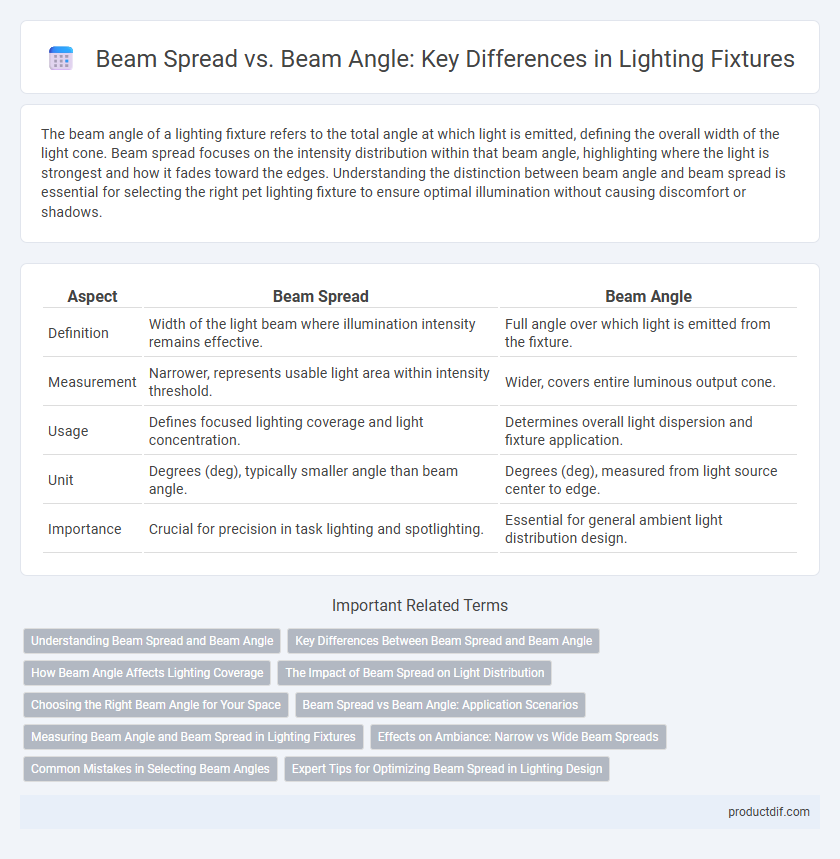The beam angle of a lighting fixture refers to the total angle at which light is emitted, defining the overall width of the light cone. Beam spread focuses on the intensity distribution within that beam angle, highlighting where the light is strongest and how it fades toward the edges. Understanding the distinction between beam angle and beam spread is essential for selecting the right pet lighting fixture to ensure optimal illumination without causing discomfort or shadows.
Table of Comparison
| Aspect | Beam Spread | Beam Angle |
|---|---|---|
| Definition | Width of the light beam where illumination intensity remains effective. | Full angle over which light is emitted from the fixture. |
| Measurement | Narrower, represents usable light area within intensity threshold. | Wider, covers entire luminous output cone. |
| Usage | Defines focused lighting coverage and light concentration. | Determines overall light dispersion and fixture application. |
| Unit | Degrees (deg), typically smaller angle than beam angle. | Degrees (deg), measured from light source center to edge. |
| Importance | Crucial for precision in task lighting and spotlighting. | Essential for general ambient light distribution design. |
Understanding Beam Spread and Beam Angle
Beam spread refers to the width of light emitted from a fixture measured at the point where intensity drops to 50% of the peak, while beam angle encompasses the total angle of emitted light including the outer edges where illumination fades. Understanding beam angle helps in selecting fixtures for general lighting coverage, whereas beam spread is crucial for precise focus and accent lighting. Accurate knowledge of both parameters ensures optimal lighting design for specific applications, balancing brightness and coverage effectively.
Key Differences Between Beam Spread and Beam Angle
Beam spread refers to the width of light emitted by a fixture at a specific intensity level, typically measured where brightness falls to 50% of the maximum. Beam angle is the total angular distance over which light is emitted, encompassing the full illuminated area. The key difference lies in beam spread indicating the region of strongest illumination, while beam angle defines the overall coverage of the light beam.
How Beam Angle Affects Lighting Coverage
Beam angle directly determines the coverage area of a lighting fixture by defining the width of the light cone emitted. A wider beam angle results in broader, more diffuse lighting suitable for ambient illumination, while a narrower beam angle produces concentrated light ideal for accent or task lighting. Understanding the beam angle is essential for optimizing lighting design to ensure appropriate brightness distribution across a space.
The Impact of Beam Spread on Light Distribution
Beam spread significantly influences light distribution by determining how broadly light disperses from a fixture, directly affecting illumination coverage and intensity. A narrower beam spread concentrates light, producing focused, intense illumination ideal for highlighting specific areas, while a wider beam spread diffuses light over larger spaces, creating uniform ambient lighting. Understanding beam spread is essential for optimizing lighting design to balance brightness, minimize glare, and enhance spatial aesthetics.
Choosing the Right Beam Angle for Your Space
Selecting the right beam angle for your lighting fixture ensures optimal illumination and ambiance tailored to your space's function and size. Beam spread refers to the width of light distribution, while the beam angle measures the cone of light emitted by the fixture; narrower beam angles (10deg-25deg) create focused, intense lighting for accent or task purposes, and wider angles (40deg-60deg) provide broad, diffuse lighting ideal for general or ambient use. Matching beam angle to room dimensions and desired lighting effect enhances visual comfort and energy efficiency.
Beam Spread vs Beam Angle: Application Scenarios
Beam spread and beam angle determine the distribution of light for various lighting fixture applications. Narrow beam angles, typically under 25 degrees, concentrate light for spotlighting or accent lighting, highlighting specific objects or architectural features. Wider beam spreads, above 40 degrees, provide diffuse illumination suitable for general area lighting and ambient environments.
Measuring Beam Angle and Beam Spread in Lighting Fixtures
Measuring beam angle in lighting fixtures involves determining the full width at half maximum (FWHM) of the light intensity distribution, representing the angle where illumination reaches 50% of its peak intensity. Beam spread refers to the total area over which light is dispersed, often measured by the angle encompassing 90% of the luminous flux. Precise measurement techniques use goniometers or photometric equipment to capture angular light distribution, ensuring accurate assessment of beam characteristics for optimal lighting design.
Effects on Ambiance: Narrow vs Wide Beam Spreads
Narrow beam spreads create concentrated pools of light that enhance dramatic accents and highlight specific areas, adding depth and sophistication to a space. Wide beam spreads distribute light more evenly, producing a softer, ambient illumination that fosters a welcoming and comfortable atmosphere. Selecting the appropriate beam angle directly influences the mood, functionality, and overall visual impact of interior and exterior environments.
Common Mistakes in Selecting Beam Angles
Common mistakes in selecting beam angles for lighting fixtures often stem from confusing beam spread with beam angle, which leads to improper light distribution and suboptimal illumination. Beam angle defines the full width at half maximum (FWHM) of the light output, while beam spread considers the total area illuminated, affecting how a space is lit. Understanding the distinction ensures accurate lighting design, avoids over- or under-lighting, and optimizes energy use.
Expert Tips for Optimizing Beam Spread in Lighting Design
Beam spread defines the width of the illuminated area on a surface, while beam angle measures the full width of the light cone emitted by a fixture. To optimize beam spread in lighting design, select fixtures with adjustable lenses or controlled reflector shapes that provide precise light distribution tailored to the project's spatial requirements. Expert tips include considering the light intensity fall-off and distance, ensuring that the beam spread adequately balances coverage and brightness without causing glare or excessive spill.
Beam spread vs Beam angle Infographic

 productdif.com
productdif.com